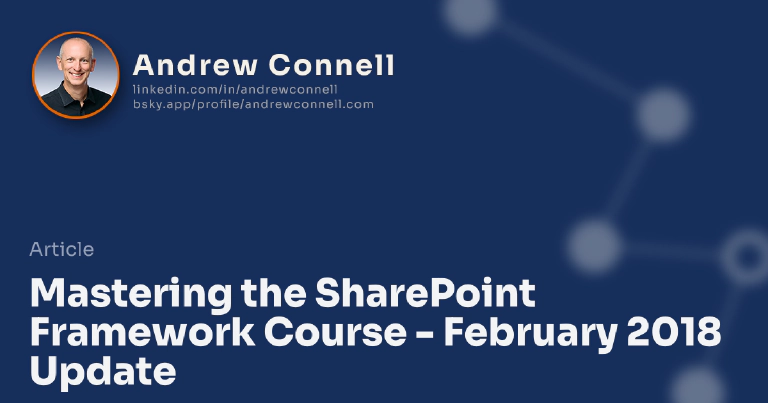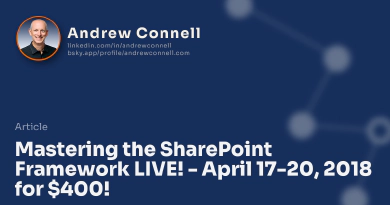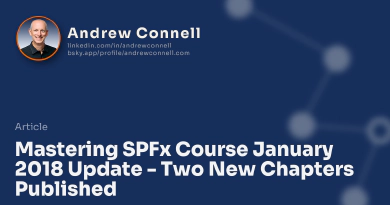My development course, Mastering the SharePoint Framework, is currently in pre-release. That means it isn’t content complete but subscribers will receive access to all content added to the course in the future.
Today I wrapped up and published sprint 8 which means I’m happy to share that one new chapter has been published to the Fundamentals course and are immediately available to all Mastering the SharePoint Framework Fundamentals & Ultimate bundle subscribers. In addition, a couple of lessons had minor bugfixes applied. This update also included a significant update to the Deployment to Production chapter with a bunch of new content!
In addition, for those who are not subscribers of one of the two paid options, the Starter bundle includes a chapter with an overview lesson from each chapter. You will find overview lessons from these two new chapters are now listed in the chapter Fundamentals Chapters (Preview).
As always, you can see details on the latest updates to the course on the course update page on our site.
New Chapter Published
The following chapter has been added to the Fundamentals course:
Branding & Design: CSS, Themes, and Office UI Fabric
Design is something that all projects should factor into the development process as it has significant impacts on the usability, experience and therefore adoption of all custom solutions. You can think of design from two angles: organization and branding. This chapter will first look at some design elements to consider when building custom SPFx solutions. We will then cover the branding aspect from leveraging custom CSS, leveraging SharePoint themes as well as taking advantage of different visual design languages such as Bootstrap, Material and the Office UI Fabric from Microsoft.
Updated Chapter
Microsoft has released a lot of deployment-related features in the last part of 2017 and early part of 2018 since the chapter on Deployment to Production has been published. Sprint 8 includes a bunch of updates and new content for deployment tasks. Specifically, you will find updated and new content related to:
- SharePoint REST ALM APIs
- REST API endpoints
- Using the SharePoint PnP PowerShell module to deploy and manage the package lifecycle
- Using the Office 365 CLI to deploy and manage the package lifecycle
- Tenant and Site Collection App Catalogs
- Including Assets in package files
- Leveraging and configuring Office 365 CLI
- Including support for included assets in packages
- Configuring using the SharePoint PowerShell
- Configuring using the Office 365 CLI
What’s Next for Mastering the SharePoint Framework - Sprint 9
So what’s next for the class? I was originally going to work on the chapters related to leveraging the Microsoft Graph and third-party data via external or custom REST APIs, but in the last few weeks, the SharePoint Framework v1.4.1 update included a lot of changes to both of these topics ( you can read more about these changes and see a 15-minute screencast of it from this blog post).
This update not only introduced a completely new Microsoft Graph API, deprecating the previous API in the SharePoint Framework, but also introduced a new API for Microsoft Entra ID which is used for calling third party APIs. Both of these were released in preview. Because APIs can change significantly before a generally available (GA) release, I’m going to push these chapters out until these APIs are solid. I hope they will go GA in an announcement at either Microsoft’s Build conference or the SharePoint Conference - North America in May.
Instead, sprint 9 will include chapters on using web frameworks with the SharePoint Framework. My sprints typically include two chapters. One of the sprint 9 chapters will be devoted to the React web framework as you overwhelmingly said that’s what was most important. The other chapter is still undecided.
According to the survey, the clear second choice is Angular, but Google hasn’t finished the Angular Elements feature that will make Angular v5.0 viable in SharePoint Framework projects. The next two frameworks people were interested in were jQuery and Vue.js.
I’m going to focus on the React chapter first, then if Angular Elements is complete, I’ll work on the Angular chapter. Otherwise, it might be jQuery / Vue.js… we’ll see.
One more thing… sprints are typically 2-3 weeks long. However, March is a very busy month. I’m presenting at two conferences (Collab Summit March 1-3 & SPFest Washington DC March 25-30) and attending the MVP Summit (March 4-9). I don’t expect to wrap up and publish sprint 9 until mid to late April due to all this extra work.
That’s it for this month’s update. Got a question or feedback? Hit reply and let me know!

Microsoft MVP, Full-Stack Developer & Chief Course Artisan - Voitanos LLC.
Andrew Connell is a full stack developer who focuses on Microsoft Azure & Microsoft 365. He’s a 20+ year recipient of Microsoft’s MVP award and has helped thousands of developers through the various courses he’s authored & taught. Whether it’s an introduction to the entire ecosystem, or a deep dive into a specific software, his resources, tools, and support help web developers become experts in the Microsoft 365 ecosystem, so they can become irreplaceable in their organization.






